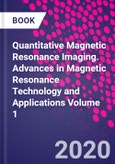Quantitative Magnetic Resonance Imaging is a 'go-to' reference for methods and applications of quantitative magnetic resonance imaging, with specific sections on Relaxometry, Perfusion, and Diffusion.Each section will start with an explanation of the basic techniques for mapping the tissue property in question, including a description of the challenges that arise when using these basic approaches. For properties which can be measured in multiple ways, each of these basic methods will be described in separate chapters. Following the basics, a chapter in each section presents more advanced and recently proposed techniques for quantitative tissue property mapping, with a concluding chapter on clinical applications.
The reader will learn:
- The basic physics behind tissue property mapping
- How to implement basic pulse sequences for the quantitative measurement of tissue properties
- The strengths and limitations to the basic and more rapid methods for mapping the magnetic relaxation properties T1, T2, and T2*
- The pros and cons for different approaches to mapping perfusion
- The methods of Diffusion-weighted imaging and how this approach can be used to generate diffusion tensor
- maps and more complex representations of diffusion
- How flow, magneto-electric tissue property, fat fraction, exchange, elastography, and temperature mapping are performed
- How fast imaging approaches including parallel imaging, compressed sensing, and Magnetic Resonance
- Fingerprinting can be used to accelerate or improve tissue property mapping schemes
- How tissue property mapping is used clinically in different organs
Please Note: This is an On Demand product, delivery may take up to 11 working days after payment has been received.
Table of Contents
Introduction
SECTION 1 Relaxometry 1. Biophysical and Physiological Principles of T1 and T2 2. Quantitative T1 and T1r Mapping 3. Quantitative T2 and T2* Mapping 4. Multiproperty Mapping Methods 5. Specialized Mapping Methods in the Heart 6. Advances in Signal Processing for Relaxometry 7. Relaxometry: Applications in the Brain 8. Relaxometry: Applications in Musculoskeletal Systems 9. Relaxometry: Applications in the Body 10. Relaxometry: Applications in the Heart
SECTION 2 Perfusion and Permeability 11. Physical and Physiological Principles of Perfusion and Permeability 12. Arterial Spin Labeling MRI: Basic Physics, Pulse Sequences, and Modeling 13. Dynamic Contrast-Enhanced MRI: Basic Physics, Pulse Sequences, and Modeling 14. Dynamic Susceptibility Contrast MRI: Basic Physics, Pulse Sequences, and Modeling 15. Applications of Quantitative Perfusion and Permeability in the Brain 16. Applications of Quantitative Perfusion and Permeability in the Liver 17. Applications of Quantitative Perfusion and Permeability in the Body
SECTION 3 Diffusion 18. Physical and Physiological Principles of Diffusion 19. Acquisition of Diffusion MRI Data 20. Modeling Fiber Orientations Using Diffusion MRI 21. Diffusion MRI Fiber Tractography 22. Measuring Microstructural Features Using Diffusion MRI 23. Diffusion MRI: Applications in the Brain 24. Diffusion MRI: Applications Outside the Brain
SECTION 4 Fat and Iron Quantification 25. Physical and Physiological Properties of Fat 26. Physical and Physiological Properties of Iron 27. Fat Quantification Techniques 28. Applications of Fat Mapping 29. Iron Mapping Techniques and Applications
SECTION 5 Quantification of Other MRI-Accessible Tissue Properties 30. Electrical Properties Mapping 31. Quantitative Susceptibility Mapping 32. Magnetization Transfer 33. Chemical Exchange Mapping 34. MR Thermometry 35. Motion Encoded MRI and Elastography 36. Flow Quantification with MRI 37. Hyperpolarized Magnetic Resonance Spectroscopy and Imaging








